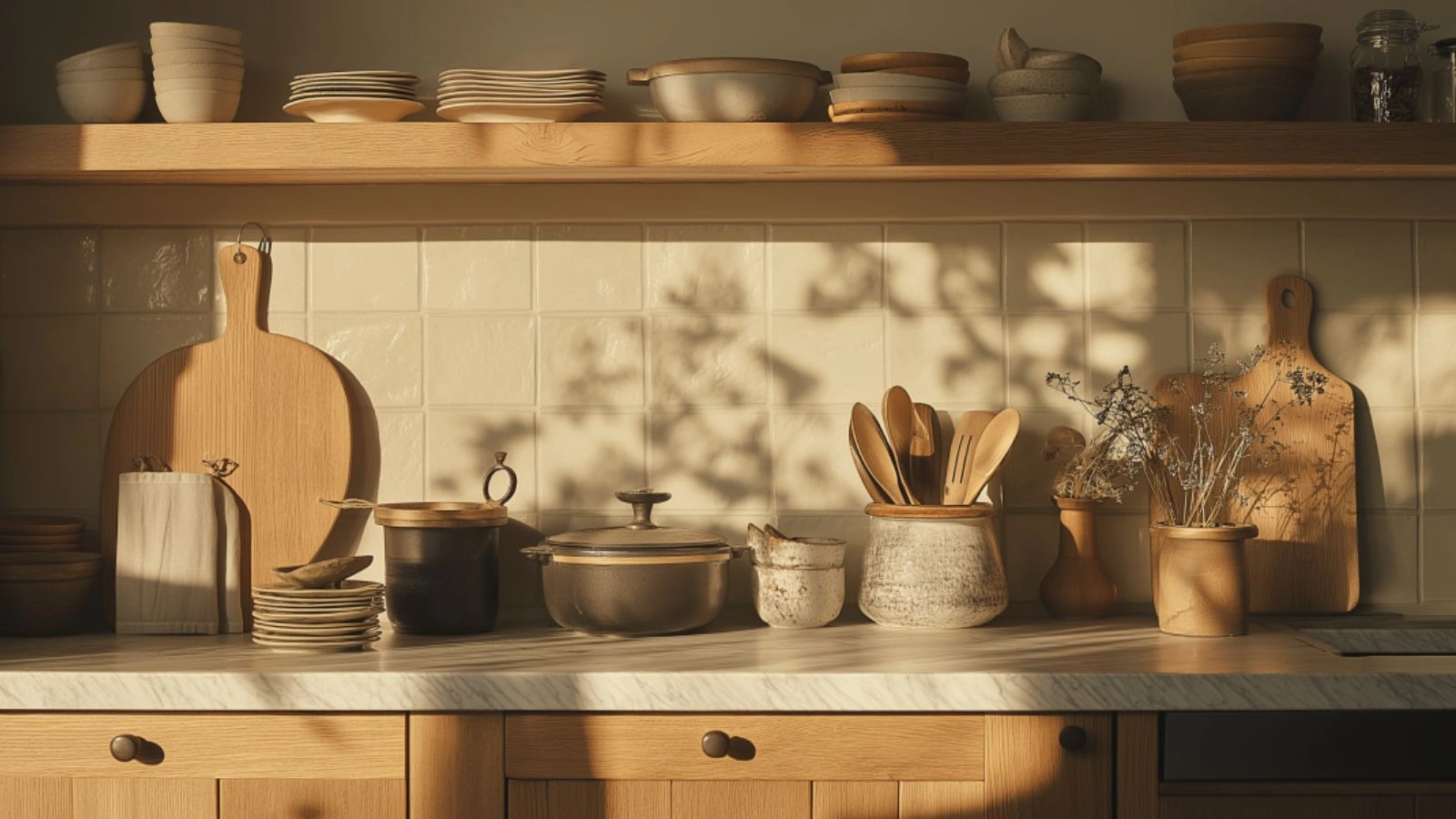Modern Calm: Transform Your Home with Japandi Kitchen Design Elements
Table of Contents
In today’s fast-paced world, more homeowners are seeking spaces that offer simplicity, serenity, and meaningful functionality. It’s no wonder that Japandi kitchen design—where Japanese minimalism meets Scandinavian warmth—has become a standout style in contemporary home design. Merging the best of two distinct philosophies, Japandi creates kitchens that feel intentional, elegant, and deeply calming.
According to a 2024 interior design report, Japandi-inspired elements are among the top trends in kitchen renovations, especially in urban and minimalist households. The appeal lies in its balance: the clean lines of Japanese design harmonize with the cozy textures of Scandinavian interiors, resulting in a look that’s modern yet timeless.
This guide explores the essential Japandi kitchen design elements you can incorporate to transform your space. Whether you’re doing a complete remodel or simply refreshing your layout, you’ll find actionable ideas to infuse calm and beauty into the heart of your home.
Neutral Color Palettes That Reflect Nature and Peace
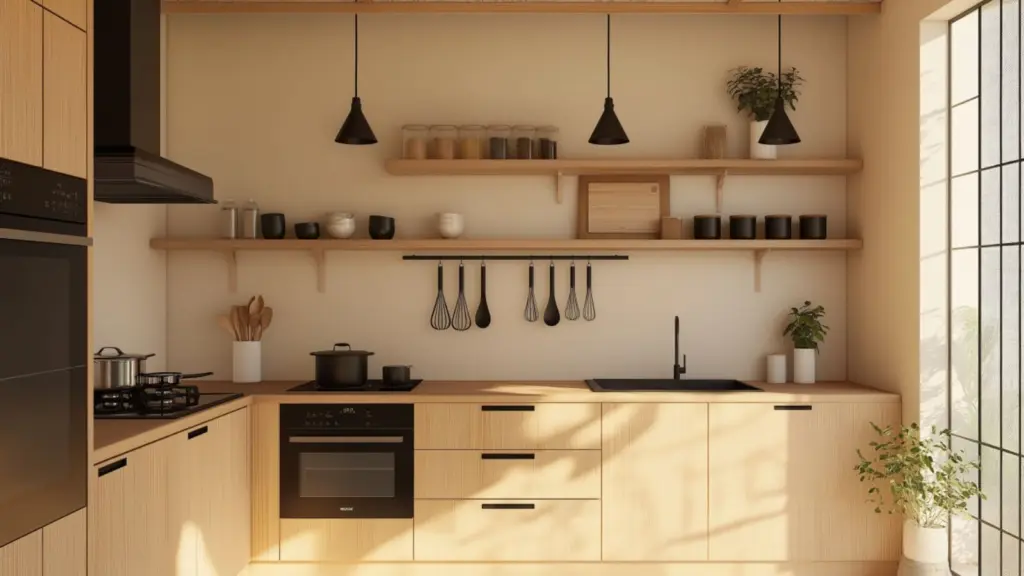
One of the core principles of Japandi design is the use of soft, neutral color schemes. These palettes reflect a grounded connection to nature and create an atmosphere of tranquility in your kitchen.
Warm whites, muted taupes, soft greys, and natural beige tones dominate the Japandi color story. Often layered in gradients, these shades promote visual harmony without becoming sterile or cold. Wood textures—especially in light oak, ash, and walnut—add subtle contrast while preserving the minimalist foundation.
Common Japandi Color Combinations
| Primary Base | Complementary Tones | Accent Hues |
|---|---|---|
| Warm White | Sand, Soft Taupe | Charcoal, Matte Black |
| Sage Green | Ivory, Clay | Brass, Natural Wood |
| Light Grey | Blonde Oak, Off-White | Deep Blue, Graphite |
By choosing a palette rooted in calm tones, you encourage a sense of balance and clarity—perfect for mindful cooking and connection.
Clean Lines and Functional Layouts That Breathe
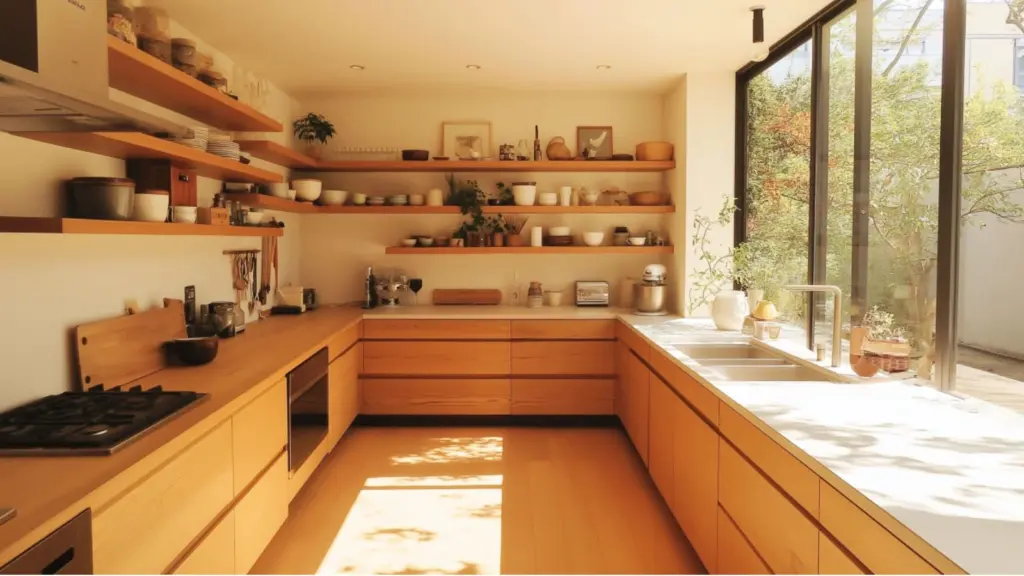
Japandi kitchens are defined by clean architectural lines and layouts that prioritize function. Cabinets are typically handleless or designed with minimalist pulls to enhance the visual flow. Furniture and fixtures avoid ornate detailing in favor of simple, geometric silhouettes.
A typical Japandi kitchen layout favors open sightlines, spacious counters, and unobstructed movement. This creates a feeling of calm and avoids the sensory overload often found in more cluttered kitchens.
Essential Layout Features
| Design Element | Purpose | Japandi Style Focus |
|---|---|---|
| Open Countertops | Encourage clarity and purpose | Avoids visual chaos |
| Hidden Storage | Maintains seamless look | Supports minimalism |
| Integrated Appliances | Keeps lines clean | Enhances functionality discreetly |
| Floating Shelving | Opens up space visually | Displays essentials with intention |
Even small kitchens can adopt Japandi principles by reducing unnecessary hardware, decluttering surfaces, and selecting cabinetry with smooth, matte finishes.
Natural Materials That Ground the Space
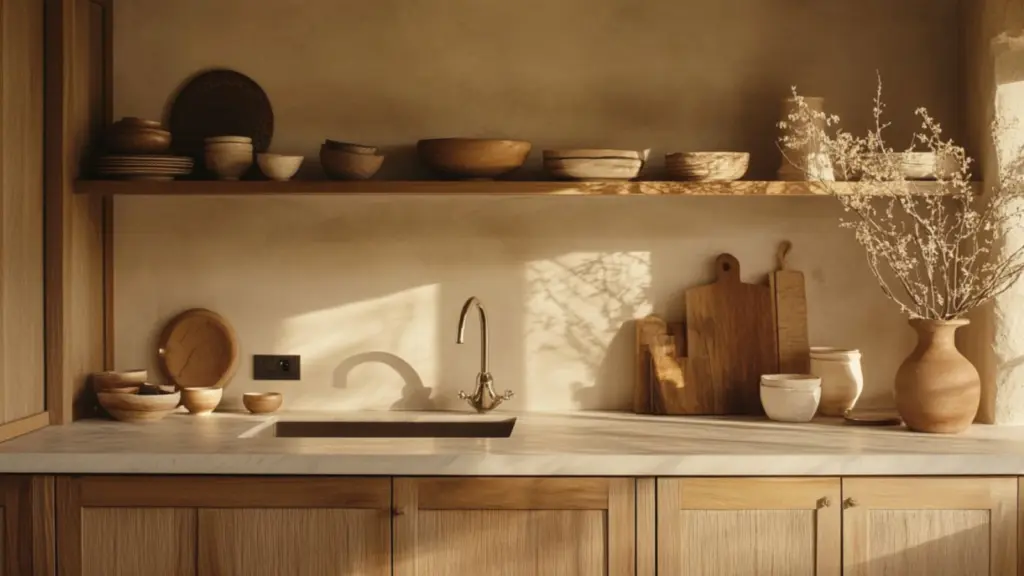
Bringing the outdoors in is fundamental to Japandi design. Natural materials are not just an aesthetic choice—they create a sensory connection to the environment and ground the kitchen in authenticity.
Wood is the hero material in Japandi kitchens. You’ll often find lightly stained oak, rich walnut, or bamboo elements paired with stone surfaces, linen textiles, and ceramic accessories. Together, these elements bring texture and warmth into a refined, neutral space.
Top Natural Materials in Japandi Kitchens
| Material | Common Usage | Sensory Benefit |
|---|---|---|
| Oak or Walnut | Cabinetry, shelves, trim | Warmth and texture |
| Stone (Marble or Soapstone) | Countertops, backsplashes | Cool, organic visual balance |
| Ceramic | Dishes, planters, pendant lights | Adds handcrafted, artisanal detail |
| Linen | Curtains, tea towels, accents | Softens visual rigidity |
Lighting That Softly Illuminates and Enhances Calm
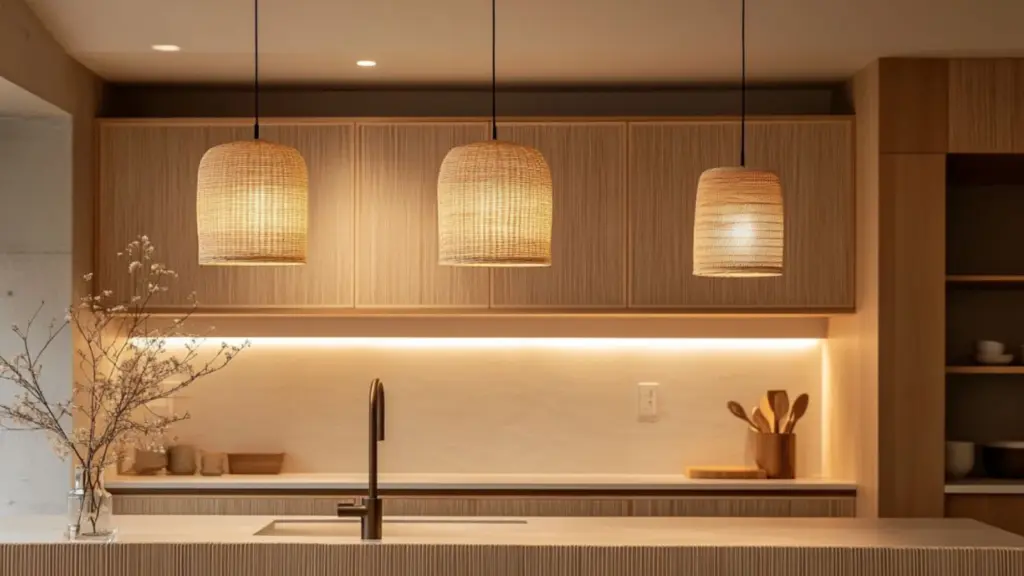
Lighting plays a crucial role in Japandi kitchen design. It is used not only for illumination but also for shaping the mood of the space. Avoid overly bright or stark white lights, which can disrupt the warm, grounded feeling of a Japandi interior.
Instead, opt for warm-toned LED lighting, pendant fixtures made from organic materials like wood or paper, and under-cabinet lighting that softly illuminates workspaces. The goal is to bathe the space in a gentle, ambient glow that feels restful and functional.
Japandi Lighting Solutions
| Fixture Type | Best Placement | Material Inspiration |
|---|---|---|
| Pendant Lights | Above kitchen island or sink | Rattan, paper, ceramic |
| Under-Cabinet LEDs | Task areas without visual clutter | Matte-finished strips |
| Wall Sconces | Dining or breakfast nooks | Brass, wood tones |
A layered lighting plan brings flexibility and comfort to all times of the day, from early morning tea to quiet evening dinners.
Decluttered Surfaces and Intentional Styling
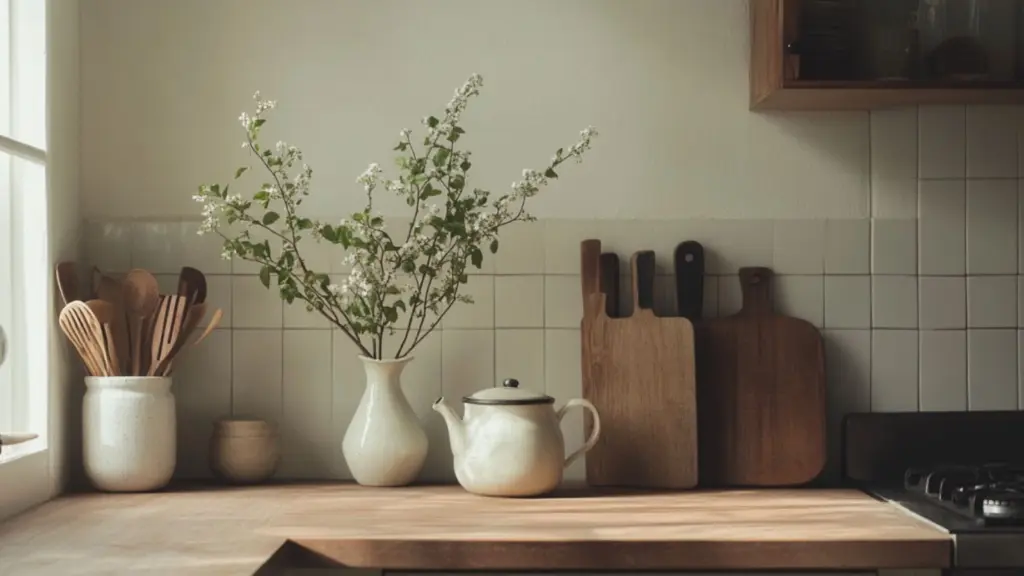
A defining trait of Japandi design is the principle of “less, but better.” This approach guides the way you style your kitchen—every item should serve a purpose or contribute to a serene visual story.
Keep countertops mostly clear, displaying only a few hand-picked items: a ceramic teapot, a small wooden cutting board, or a minimalist vase with a sprig of greenery. Open shelving should feature a curated mix of practical and aesthetic pieces—never overcrowded.
Japandi Styling Guide
| Item Type | Display Style | Why It Works |
|---|---|---|
| Ceramic Dishware | Neatly stacked or on peg rails | Celebrates craftsmanship |
| Wooden Utensils | Stored in clay vessels or trays | Adds warmth and texture |
| Live Greenery | Small potted herbs or branches | Introduces life and movement |
| Fabric Textiles | Rolled linen towels or tea cloths | Softens hard surfaces |
This minimalist styling fosters mindfulness and transforms daily routines—like brewing tea or prepping food—into calming rituals.
Embracing Wabi-Sabi with Organic Imperfection
At the heart of Japandi style is the philosophy of wabi-sabi—the appreciation of imperfection and impermanence. While Scandinavian design leans toward clean symmetry, wabi-sabi encourages organic shapes, patinas, and the visible marks of use and time.
In the kitchen, this might mean using handmade ceramics with slight irregularities, raw-edged wooden serving boards, or vintage cookware with character. These elements add depth and authenticity to the space, creating a kitchen that tells a story.
How to Introduce Wabi-Sabi Elements
| Item or Material | Imperfection Type | Visual or Emotional Effect |
|---|---|---|
| Handcrafted Pottery | Uneven glaze, unique shapes | Adds soul and individuality |
| Aged Wood | Weathered grain, knots | Grounds the space in nature |
| Woven Baskets | Slight asymmetry, handmade texture | Invites warmth and softness |
| Vintage Finds | Signs of age, patina | Adds history and nostalgia |
These imperfections make a Japandi kitchen feel more human, more real, and infinitely more calming.
Conclusion
Japandi kitchen design is more than a trend—it’s a lifestyle rooted in mindfulness, balance, and appreciation for beauty in simplicity. By combining Scandinavian warmth with Japanese minimalism, you create a space that supports well-being and offers calm in everyday routines.
Whether you embrace Japandi in small touches or through a full kitchen transformation, the principles remain the same: thoughtful design, natural materials, and purposeful living. In a world that moves quickly, the modern calm of a Japandi kitchen is a welcome retreat.

